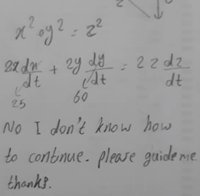You are using an out of date browser. It may not display this or other websites correctly.
You should upgrade or use an alternative browser.
You should upgrade or use an alternative browser.
related rates
- Thread starter Sara.H
- Start date
View attachment 21798 please help me for solve this problem.
Sara.H, do not post your problem in someone else's thread. Go back to the
top of the "Calculus" section and start your own thread with a subject line.
Also, please post what work you have contributed toward the problem .....................................(moved problem as suggested)
D
Deleted member 4993
Guest
If I were to do this problem, I would sketch putting the cars at the origin and one would travel negative x direction (west) and the other would travel negative y direction (south). Now define the speeds as dx/dt and dy/dt and the distance between those cars at anytime 't' would be r(t).View attachment 21798 please help me for solve this problem.
Please show us what you have tried and exactly where you are stuck.
Please follow the rules of posting in this forum, as enunciated at:
Please share your work/thoughts about this problem.
HallsofIvy
Elite Member
- Joined
- Jan 27, 2012
- Messages
- 7,763
First, write the distance the south moving car is from the original point in terms of time, t. Second write the distance the west moving car is from the original point in terms of time, t. Third write the distance between the two cars in terms of time, t (hint: Pythagorean theorem). Finally differentiate that with respect to t to get a rate.
(The arithmetic turns out to be surprisingly simple!)
(The arithmetic turns out to be surprisingly simple!)
D
Deleted member 4993
Guest
Yes - 122 + 52 = 132First, write the distance the south moving car is from the original point in terms of time, t. Second write the distance the west moving car is from the original point in terms of time, t. Third write the distance between the two cars in terms of time, t (hint: Pythagorean theorem). Finally differentiate that with respect to t to get a rate.
(The arithmetic turns out to be surprisingly simple!)
Steven G
Elite Member
- Joined
- Dec 30, 2014
- Messages
- 14,383
- 122 + 52 = 132???Yes - 122 + 52 = 132
D
Deleted member 4993
Guest
It is NOT: -12^2 - it is - - 12^2- 122 + 52 = 132???
There is a space - a sea of quarks and electrons between that 12 and - (hyphen).
Steven G
Elite Member
- Joined
- Dec 30, 2014
- Messages
- 14,383
I understand now. Thanks for explaining it to me.It is NOT: -12^2 - it is - - 12^2
There is a space - a sea of quarks and electrons between that 12 and - (hyphen).
First, write the distance the south moving car is from the original point in terms of time, t. Second write the distance the west moving car is from the original point in terms of time, t. Third write the distance between the two cars in terms of time, t (hint: Pythagorean theorem). Finally differentiate that with respect to t to get a rate.
(The arithmetic turns out to be surprisingly simple!)
Attachments
D
Deleted member 4993
Guest
Now use the equation you had derived. After 2 hrs:
x = ?
y = ?
r = ?
dx/dt = ?
dy/dt = ?
Now calculate dr/dt = ?
x = ?
y = ?
r = ?
dx/dt = ?
dy/dt = ?
Now calculate dr/dt = ?
I don't know x and yNow use the equation you had derived. After 2 hrs:
x = ?
y = ?
r = ?
dx/dt = ?
dy/dt = ?
Now calculate dr/dt = ?
D
Deleted member 4993
Guest
I don't know x and y
Did you read the above (response #3)?If I were to do this problem, I would sketch putting the cars at the origin and one would travel negative x direction (west) and the other would travel negative y direction (south). Now define the speeds as dx/dt and dy/dt and the distance between those cars at anytime 't' would be r(t).
This problem has not given us an x and y.Did you read the above (response #3)?
D
Deleted member 4993
Guest
However, it did give you data using which you can calculate x and y.This problem has not given us an x and y.
Read the problem again.
How long (time) after starting, we need to measure distance?
What are the respective speeds of each car? What is the equation that combines constant speed, distance and time?
Now I ask again:
x = ?
y = ?
ok is it mean that x=120 and y=50?However, it did give you data using which you can calculate x and y.
Read the problem again.
How long (time) after starting, we need to measure distance?
What are the respective speeds of each car? What is the equation that combines constant speed, distance and time?
Now I ask again:
D
Deleted member 4993
Guest
What do you think? Are you wrong or correct?ok is it mean that x=120 and y=50?
According to the definition of speedWhat do you think? Are you wrong or correct?
Sorry x=50 and y=120What do you think? Are you wrong or correct?

